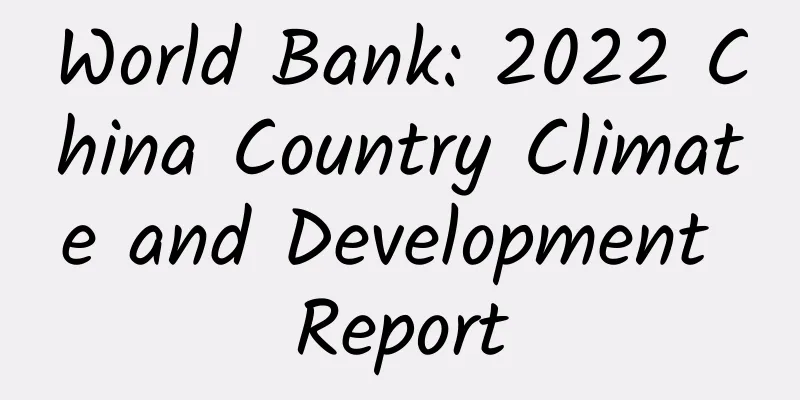World Bank: 2022 China Country Climate and Development Report

|
The China National Climate and Development Report provides analysis and recommendations on how China can coordinate the goals of high-quality development with emission reduction and climate resilience. If China does not take adequate measures to mitigate and adapt to climate change, climate risks will increasingly become a constraint on China's long-term growth and prosperity and may reverse development gains. Therefore, China needs to balance economic growth and green development. This report provides policy options for achieving this dual goal, including reducing the inevitable trade-offs between development and climate goals and maximizing the potential synergies between the two. China's climate ambitions and development opportunities China's development is deeply intertwined with climate change. China is both a major participant in the rise of global greenhouse gas emissions and a deep victim of its adverse effects. Like other major pollutant emitters, China's contribution to reducing global climate-related risks is crucial. Reducing greenhouse gas emissions in the development of a highly carbon-intensive chemical industry economy is not an easy task. This will bring certain transition risks, but also open up rare new development opportunities. This detailed report is firmly based on China's own development goals and climate vision. Climate change poses a major threat to China’s long-term growth and prosperity. Rising sea levels and the risks of coastal flooding, storm surges and coastal erosion threaten China’s densely populated, low-lying coastal cities, which account for one-fifth of China’s population and one-third of its GDP. Meanwhile, inland provinces in northern and western China face more frequent and extreme heat waves and droughts, leading to greater water security risks and affecting agricultural production – a major source of income, especially for China’s rural poor. China's transition to carbon neutrality and resilient development will bring risks and opportunities. While addressing climate risks is critical to ensuring long-term development, China also faces unique challenges in achieving its climate and development goals: China should achieve economic growth and carbon emissions decoupling faster and at a lower income level than developed countries. This means that China's economic structure will undergo a fundamental transformation: major changes will occur in its energy, industrial and transportation systems, cities and land use patterns. Yet China is well-positioned to turn climate action into economic opportunity. As with such dramatic shifts in the past, the transition to lower carbon intensity and adapt to climate change in China and elsewhere in the world will rapidly unleash new sources of economic growth, innovation, and employment, while reducing China’s reliance on imported energy and further improving energy security. |
Recommend
If you often wake up in this sleep stage, do you have the chance to become a genius?
Researchers have discovered the secret to the suc...
Are you curious about why there are no Sino-Russian joint venture cars?
The Chinese auto market has been very busy recent...
Bilibili’s 2020 marketing plan!
Bilibili (English name: bilibili, referred to as ...
IBM's SyNAPSE chip can simulate the brain
According to foreign media reports, three years l...
Yanse "Food Photography Tutorial Video" Online Course No. 19
Training course content: The teacher has 10 years...
The deeper the sleep, the better the quality of sleep? How important is it to have a good night's sleep?
In October 2020, survey data from the China Sleep...
Electric Technology Car News: Can the Qashqai and Koleos beat the competition in the SUV market by outperforming the competition in terms of headlights?
As cars are no longer luxury goods but necessitie...
Starting from the rectification of large-screen TV operations, China's color TV industry looks forward to 2024 on the cusp of technology
More than a decade ago, smart TVs were once very ...
360 Mini Programs are designed for all scenarios, breaking the boundaries between PC and mobile terminals.
On July 5, 2019, the 360 Mini Program public be...
How to apply for Shanxi Health Code? Shanxi Health Code application and usage instructions tutorial!
How to apply for Shanxi Health Code? Shanxi Healt...
Industry promotion is undergoing transformation: 30% of companies that buy traffic no longer do so!
Recently, the author went to Shenzhen to attend a...
The Asian Games digital torchbearer has been named, and the “trendsetter” is here!
At the opening ceremony of the 19th Asian Games i...
Which 5G phone should I choose with high cost performance? Experience the realme X50 5G and you will know the answer
With the outbreak of the 5G craze, the user marke...
Apple and Google Maps break up
In iOS 6 released two years ago, Apple removed the...
Learn 3 tricks to easily promote your product
Product promotion does not necessarily require &q...









